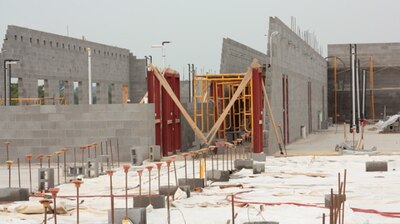It’s the season of high hopes and frazzled nerves for administrators who have applied for state aid to build or renovate schools around the state.

Hopes are high because the Building Excellent Schools Today program offers districts and charter schools access to construction and renovation funding that many couldn’t raise otherwise.
Nerves are frazzled because applying for BEST grants is a bit of a lottery – applications for state funding in the 2011-12 cycle total $372 million, but only about $187 million will be available.
Applicants will learn at the end of the month if their luck held, after the state Capital Construction Assistance Board makes its recommendations during meetings June 27-30. The State Board of Education will make the final decision on the 2011-12 list at its Aug. 11 meeting.
Applications at a glance
- 73 projects
- $553.6 million total cost; $372 million state funds, $181.5 million local
- 29 lease-purchase projects
- $509.3 million total cost
- 44 cash projects
- $44.3 million total cost
- 13 applications for new schools
- Nearly two dozen for building expansion or major renovations
- 13 applications from charters
- 17 applications ask waivers from matching requirement
The projects in this year’s list of applications have a total cost of $553.6 million, with $372 million requested in state aid and $181.5 million promised in local matching funds.
Applications come from a wide range of districts. The Denver Public Schools, the state’s second largest district by enrollment, is proposing a total of $3 million ($1.6 million from the state) for air quality, water and traffic improvement projects at multiple schools. At the other end of the enrollment scale, the 174-student Prairie district in Weld County is pitching a $16.4 million new PK-12 school, which would need $13 million in state funds. Some districts have filed multiple applications, and there are 17 applications for projects at charter schools.
Projects range from new schools (13 proposals) to a $17,608 proposal to replace a kitchen floor in the Strasburg district.
The BEST program includes two kinds of grants, cash and lease-purchase. Cash grants typically are for smaller maintenance and renovation projects, such as Strasburg’s kitchen floor, roof replacements, heating system upgrades, fire alarm replacements and the like. Cash grants are awarded as lump sums and not financed as debt.
Eighteen of this year’s applications are for roof repairs. In past cycles some board members have complained about districts relying too heavily on the BEST program for fixing bad roofs.
This year’s list includes 44 applications totaling $44.3 million, including $27 million in state funds and $17.2 million in local matches. Seventeen projects are large enough that they can be considered for cash or lease-purchase status.
For lease-purchase projects, mostly major renovations, addition of new wings and new schools, state and local funds are pooled to pay off what are called certificates of participation. Those are financial instruments bought by outside investors. The proceeds are used to build the projects, and investors are paid back over time from the state and local funds.
There are 29 applications for lease-purchase projects, seven from charters. The total costs are $509.3 million, $345 million from the state and $164.3 million in matching funds.
The BEST law, passed by the legislature in 2008, includes a formula for determining how much matching money a district must provide, based on a variety of factors. A district or charter school can request a waiver from the match percentage assigned to a particular project. Districts get automatic waivers if they don’t have sufficient bonding capacity to raise the required match for a given project.
Top 5 lease-purchase requests (in millions)
- Montezuma-Cortez, build 3 schools and renovate 2, $83.4
- Sheridan, build 1 and renovate 1, $28.3
- Lake County, high school renovation, $27.3
- Westminster, new elementary school, 1, $24.3
- Otis, school addition, $24.2
Under state law, the construction board must give priority to projects that address health and safety hazards, followed by projects to relieve overcrowding and then technology upgrades. Other kinds of projects come after those.
The staff of the Division of Public School Capital Construction Assistance evaluates every application based on condition of existing buildings, cost of replacement, suitability for education programs and energy use.
The board is allowed to consider other factors in making its recommendations, including the strength of an applicant’s planning process, costs per square foot and per student, an applicant’s ongoing ability to maintain a building, financial factors that may affect an applicant’s match and other factors.
There was some confusion and a few hurt feelings last year because some applicants assumed the ordered list of applications presented to the board by staff was a prioritized list. Some applicants were upset when the board picked winning projects from different parts of the list, based on a variety of factors.
The division and board have taken care this year to explain the selection process better, and for the first time, applicants this year will be allowed to make two-minute presentations to the board and also to respond to board members questions.
Last year the construction board recommended and the State Board of Education approved $252.1 million in school construction projects for 2010-11. That list included $232.3 million for lease-purchase projects ($165.5 million state, the rest local matches) and $19.8 million in cash grants ($11.3 million state).
There were 102 applicants for 2010-11 BEST grants. Of those 46 received awards, including 35 cash grants and 11 lease-purchase projects. The original set of applications totaled $627.2 million in project costs.
The BEST program is funded by a portion of revenues from state school trust funds, some Colorado Lottery revenue and the matching funds from participating school districts, which are typically raised through voter-approved bond issues.
For 26 of this year’s applications, districts have indicated they will seek voter approval of bond issues in November if the board gives them an award.
